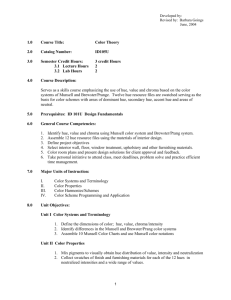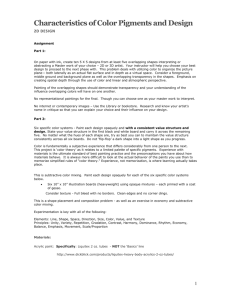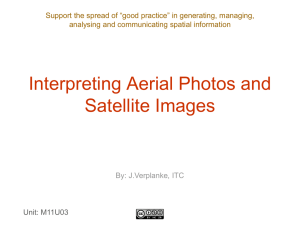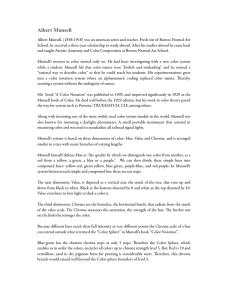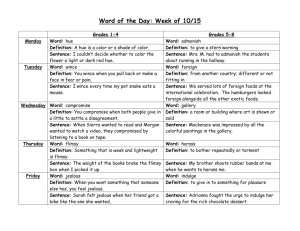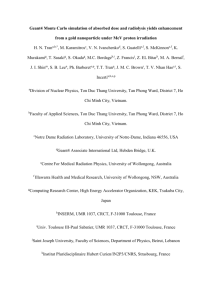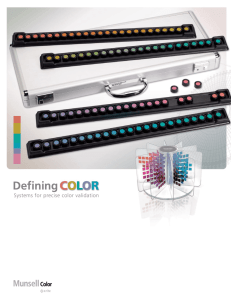Uniform color space is not homogeneous
advertisement
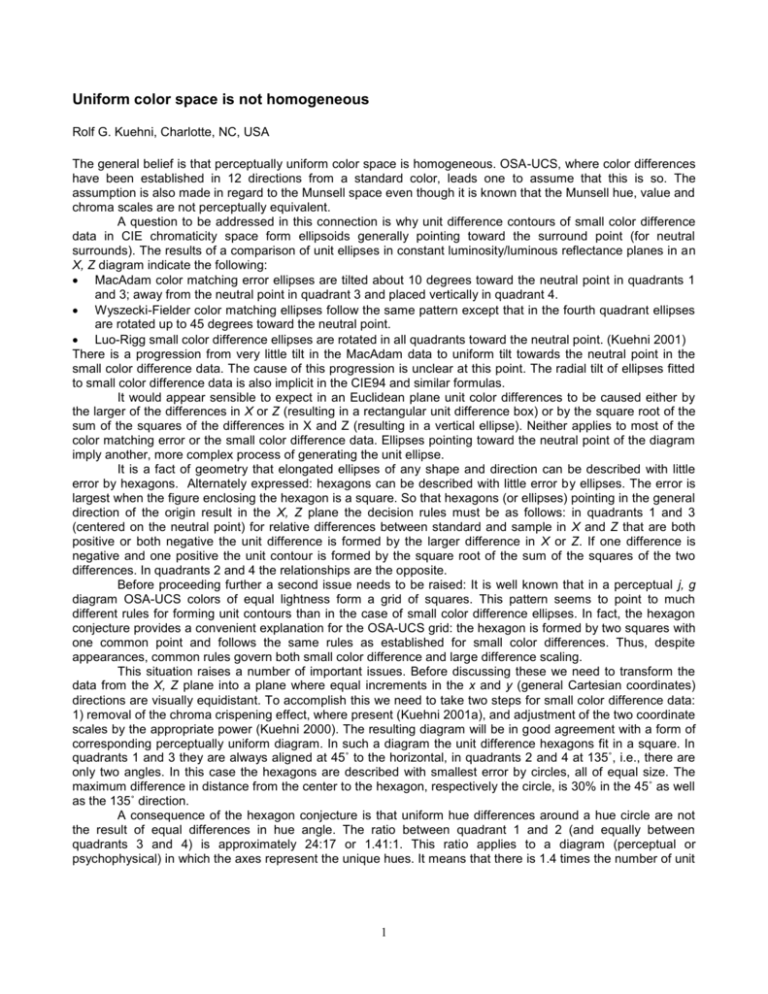
Uniform color space is not homogeneous Rolf G. Kuehni, Charlotte, NC, USA The general belief is that perceptually uniform color space is homogeneous. OSA-UCS, where color differences have been established in 12 directions from a standard color, leads one to assume that this is so. The assumption is also made in regard to the Munsell space even though it is known that the Munsell hue, value and chroma scales are not perceptually equivalent. A question to be addressed in this connection is why unit difference contours of small color difference data in CIE chromaticity space form ellipsoids generally pointing toward the surround point (for neutral surrounds). The results of a comparison of unit ellipses in constant luminosity/luminous reflectance planes in an X, Z diagram indicate the following: MacAdam color matching error ellipses are tilted about 10 degrees toward the neutral point in quadrants 1 and 3; away from the neutral point in quadrant 3 and placed vertically in quadrant 4. Wyszecki-Fielder color matching ellipses follow the same pattern except that in the fourth quadrant ellipses are rotated up to 45 degrees toward the neutral point. Luo-Rigg small color difference ellipses are rotated in all quadrants toward the neutral point. (Kuehni 2001) There is a progression from very little tilt in the MacAdam data to uniform tilt towards the neutral point in the small color difference data. The cause of this progression is unclear at this point. The radial tilt of ellipses fitted to small color difference data is also implicit in the CIE94 and similar formulas. It would appear sensible to expect in an Euclidean plane unit color differences to be caused either by the larger of the differences in X or Z (resulting in a rectangular unit difference box) or by the square root of the sum of the squares of the differences in X and Z (resulting in a vertical ellipse). Neither applies to most of the color matching error or the small color difference data. Ellipses pointing toward the neutral point of the diagram imply another, more complex process of generating the unit ellipse. It is a fact of geometry that elongated ellipses of any shape and direction can be described with little error by hexagons. Alternately expressed: hexagons can be described with little error by ellipses. The error is largest when the figure enclosing the hexagon is a square. So that hexagons (or ellipses) pointing in the general direction of the origin result in the X, Z plane the decision rules must be as follows: in quadrants 1 and 3 (centered on the neutral point) for relative differences between standard and sample in X and Z that are both positive or both negative the unit difference is formed by the larger difference in X or Z. If one difference is negative and one positive the unit contour is formed by the square root of the sum of the squares of the two differences. In quadrants 2 and 4 the relationships are the opposite. Before proceeding further a second issue needs to be raised: It is well known that in a perceptual j, g diagram OSA-UCS colors of equal lightness form a grid of squares. This pattern seems to point to much different rules for forming unit contours than in the case of small color difference ellipses. In fact, the hexagon conjecture provides a convenient explanation for the OSA-UCS grid: the hexagon is formed by two squares with one common point and follows the same rules as established for small color differences. Thus, despite appearances, common rules govern both small color difference and large difference scaling. This situation raises a number of important issues. Before discussing these we need to transform the data from the X, Z plane into a plane where equal increments in the x and y (general Cartesian coordinates) directions are visually equidistant. To accomplish this we need to take two steps for small color difference data: 1) removal of the chroma crispening effect, where present (Kuehni 2001a), and adjustment of the two coordinate scales by the appropriate power (Kuehni 2000). The resulting diagram will be in good agreement with a form of corresponding perceptually uniform diagram. In such a diagram the unit difference hexagons fit in a square. In quadrants 1 and 3 they are always aligned at 45˚ to the horizontal, in quadrants 2 and 4 at 135˚, i.e., there are only two angles. In this case the hexagons are described with smallest error by circles, all of equal size. The maximum difference in distance from the center to the hexagon, respectively the circle, is 30% in the 45˚ as well as the 135˚ direction. A consequence of the hexagon conjecture is that uniform hue differences around a hue circle are not the result of equal differences in hue angle. The ratio between quadrant 1 and 2 (and equally between quadrants 3 and 4) is approximately 24:17 or 1.41:1. This ratio applies to a diagram (perceptual or psychophysical) in which the axes represent the unique hues. It means that there is 1.4 times the number of unit 1 hue differences between red and blue compared to between blue and green. Equally, there are 1.4 times the number of unit hue differences between green and yellow compared to yellow and red. This is a startling result. What evidence is there in support of it? 1. When identifying unique hue lines in a Munsell perceptual circle they fall on diametrical lines and the lines describe circle segments in a ratio of 1.43:1. 2. When identifying higher chroma colors of unique hue in Indow and Aoki’s reconstruction of the Munsell system based on multidimensional scaling (Indow 1988) they fall on diametrical lines with the resulting circle segments in a ratio of 1.47:1 (see Figs. 1 and 2). 3. In a small experiment of directly scaled hue differences in a Munsell hue circle Kuehni found a ratio between red-blue and blue-green differences of 1.75:1. In the other half the ratio was only 1.2:1 (Kuehni 1999). But both results support the conjecture. 4. When comparing OSA-UCS grid colors not along horizontal or vertical lines but along diagonals (essentially comparing hue differences with chroma differences) 5 observers have uniformly indicated the hue differences to be perceptually larger by some 50% compared to the chroma differences. 5. Boynton and co-workers have experimentally identified the hexagonal shape of the unit difference contour at the threshold level in the cone sensitivity diagram and have pointed to the related error in conventional color difference calculation (Boynton 1983). Figure 1 Figure 2 Fig. 1 Perceptual Munsell chromatic diagram with average unique hue lines. The hue angles of the segments are in the ratio 1.43:1. Fig. 2 Reconstruction of the Munsell chromatic plane from multidimensional scaling data (Indow 1988) with lines representing average unique hues added. The hue angles of the segments are in the ratio 1.57:1. Among the conclusions are: 1. perceptual color space is not homogeneous because of the rules that govern the form of unit contours. A perceptually uniform color diagram with the unique hues falling on the axes can not be represented by a Cartesian diagram. If the unique hues do not fall on the axes the axes are perceptually meaningless. 2. Current color difference calculation is simplistic. S C and SH type adjustments are average adjustments that correct for the effects of chroma crispening, unit hexagon rules, and the inaccurate fit to visual data of the CIELAB formula. Attempts have recently been made to correct for the residual misfit with several hue angle based functions. Building a formula on the unit hexagon rules goes beyond fitting new patches to CIE94 and may have a better chance for a high degree of correlation with visual data. Initial results are promising. Boynton 1983 Indow 1988 Kuehni 1999 Kuehni 2000 Kuehni 2001a Kuehni 2001b R.M. Boynton, A.L. Nagy, C.X. Olson, A flaw in equations for predicting chromatic color difference. Col Res Appl 1983;8:69-74. T. Indow, Multidimensional studies of Munsell color solid, Psych Review 1988;95:456-470. R.G. Kuehni, Towards an improved uniform color space, Col Res Appl 1999;24;253-265. R.G. Kuehni, A comparison of five color order systems, Col Res Appl 2000;25:123-131. R.G. Kuehni, From color matching error to large color differences, Col Res Appl, in review. R.G. Kuehni, Ellipse or hexagon? Col Res Appl, submitted. 2
